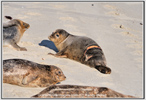| |
WHITE SHARKS & THE SEAL POPULATION
According to Department of Fish of Game, Marine Region, "white sharks play a crucial role in the marine ecosystem by helping to suppress pinniped (seals and sea lions) populations. The only real threat white sharks face are from humans, as well as the occasional killer whale."
With this information, the DFG also recommends that to avoid a shark encounter one should not "swim in or near areas frequented by sea lions, harbor seals, and elephant seals,
near their rookeries, or near the mouths of rivers where the animals concentrate
looking for fish. " |
|
Shark bitten seal at La Jolla Children's Pool 2005 |
Although this may be an issue of common sense, with this data, it is also common sense that the growing pinniped population at The Children's Pool may pose a problem for the swimmers, surfers and divers who frequent the surrounding beaches in the very near vicinity. For example, Casa Beach, a public swimming area, is immediately adjacent to The Children's Pool. The La Jolla Cove, also a public swimming and diving area, is also steps away from the La Jolla Underwater Park Ecological Reserve where white sharks are known to be born.
Sharks sitings and alleged shark bites have been increasing in the La Jolla area. The above photo shows a seal believed to be bitten by what indicates a white shark. A warning to beachgoers was issued on August 31, 2005 when the harbor seal pictured above was reported by Children's Pool lifeguards, according to the San Diego Union Tribune.
A photo was posted of an attacked seal that made it back to Children's Pool
(Click me).
|
|

